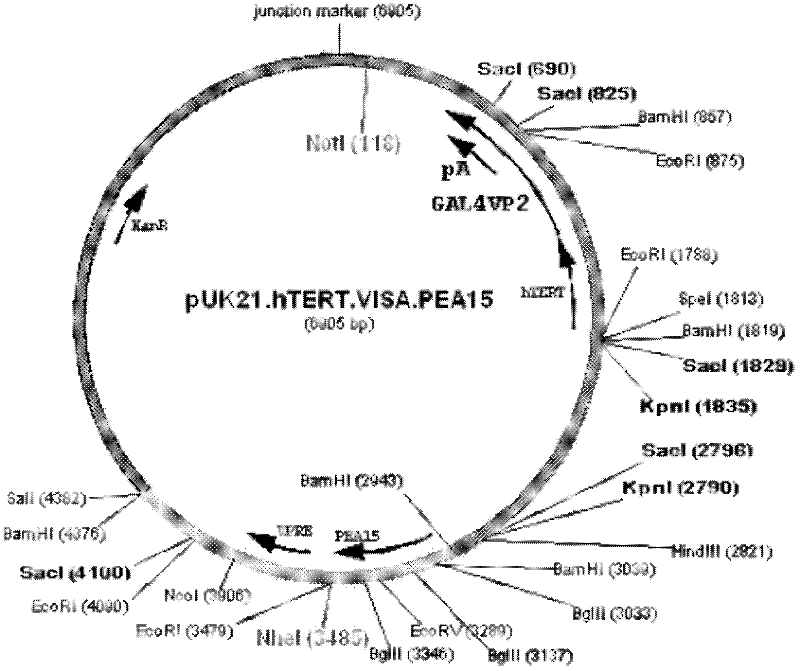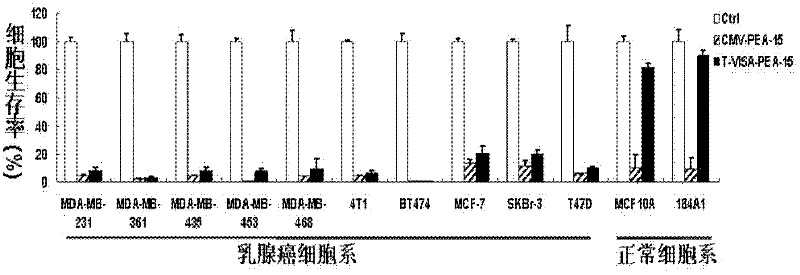Medicine T-VISA-PEA15 capable of effectively and specifically killing breast cancer cells
A T-VISA-PEA15, breast cancer cell technology, applied in the field of medicine and biology, can solve the problems of no tissue specificity of the promoter, low promoter activity, and large toxic and side effects, and achieve no liver and kidney toxicity and high gene expression. , the effect of low toxicity
- Summary
- Abstract
- Description
- Claims
- Application Information
AI Technical Summary
Problems solved by technology
Method used
Image
Examples
Embodiment 1
[0018] Example 1: Construction of T-VISA-PEA15 therapeutic vector
[0019] (1) pCRII-TOPO-hTERT plasmid clone
[0020] 1. Extract DNA from breast cancer MCF-7 cells (purchased from ATCC, USA) by conventional methods.
[0021] 2. Using the DNA as a template, design PCR primers for amplifying hTERT, hTERT PCR upstream (Forward) and downstream (Reverse) primers:
[0022] Forward: 5′-ata tct aga ggc ccc tcc ctc ggg tta ccc cac agc-3′(XbaI)
[0023] Reverse: 5′-ata gat ctt atg cgg ccg ccc acg tgc gca gca gga cgc agc gc-3′.
[0024] 3. Using breast cancer MCF-7 cell DNA as template, hTERT PCR primers (Forward: 5′-ata tct aga ggc ccc tcc ctc ggg tta ccc cac agc-3′; Reverse: 5′-ata gat ctt atg cgg ccg ccc acg tgc gca gca gga cgc agc gc-3'), Pfu DNA polymerase, dNTP and PCR reaction solution, amplify to obtain hTERT promoter (-416 to +1) product, the sequence of which is shown in SEQ ID NO.2. Its PCR reaction system: 10×PCR buffer 5μl, upstream (Forward) and downstream (Reverse) pr...
Embodiment 2
[0080] Example 2: Preparation of liposomes:
[0081] The lipids were removed from the refrigerator (DOTAP at -20°C, cholesterol at -4°C) and returned to room temperature. Heat the two rotary evaporators in a water bath to 30 °C and 50 °C, respectively. Weigh 68.75 mg of cholesterol into a 1000 ml round bottom flask. To a round bottom flask was added 100 mg of DOTAP and 25 mg of Chloroform. Swirl the flask to mix well. Rotate the round-bottomed flask in a water bath at 30°C for 2 min to make it evenly mixed and form a thin film on the wall of the flask. Turn on the vacuum aspirator for 30 min at 30°C. Add 8.9 ml of pre-warmed 5% glucose solution to dissolve the dried film, and spin rapidly at 105 rpm for 45 min at 50°C. Then reduce the temperature to 35°C and rotate for 10min. Cover the flask with plastic wrap (or paraffin) and leave at room temperature overnight, protected from light. Measure the volume and add double distilled water to 8.9 ml. The flask was sonicated ...
Embodiment 3
[0082] Example 3: Preparation of T-VISA-PEA15 liposomes
[0083] The T-VISA-PEA15 therapeutic vehicle was dissolved in a 5% glucose solution to a final concentration of 1 ug / ul, while the storage concentration (20 mM) of the liposome of Example 2 was diluted with a 5% glucose solution to a working concentration (8 mM) . 1 μg DNA / ul of T-VISA-PEA15 therapeutic vehicle was slowly added to 8mM liposome (therapeutic vehicle: liposome = 20ug: 50ul), and allowed to stand at room temperature for 20 minutes to react to form T-VISA-PEA15 lipid plastid.
[0084] Then, the quality control such as verification, biological property testing and endotoxin, etc., are aseptically packaged. Finished product inspection, packaging, and storage at 4-8 °C; put it at room temperature for 20 minutes before use, it can be used directly for in vitro research, or in vivo research, or it can be diluted with 5% glucose solution before use.
[0085] 2. Effect experiment:
PUM
| Property | Measurement | Unit |
|---|---|---|
| Particle size | aaaaa | aaaaa |
Abstract
Description
Claims
Application Information
 Login to View More
Login to View More - R&D
- Intellectual Property
- Life Sciences
- Materials
- Tech Scout
- Unparalleled Data Quality
- Higher Quality Content
- 60% Fewer Hallucinations
Browse by: Latest US Patents, China's latest patents, Technical Efficacy Thesaurus, Application Domain, Technology Topic, Popular Technical Reports.
© 2025 PatSnap. All rights reserved.Legal|Privacy policy|Modern Slavery Act Transparency Statement|Sitemap|About US| Contact US: help@patsnap.com



